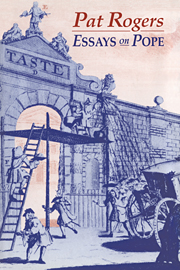Book contents
- Frontmatter
- Contents
- Preface
- Acknowledgements
- List of abbreviations
- 1 Pope and the syntax of satire
- 2 The politics of style
- 3 Form and pattern in the Pastorals
- 4 Windsor-Forest, Britannia and river poetry
- 5 Faery lore and The Rape of the Lock
- 6 Timon's Villa and Chatsworth
- 7 A drama of mixed feelings: the Epistle to Arbuthnot
- 8 The name and nature of Dulness: proper nouns in The Dunciad
- 9 Pope and the social scene
- 10 Blacks and poetry and Pope
- 11 The case of Pope v. Curll
- 12 Pope and his subscribers
- 13 The Burlington circle in the provinces: Pope's Yorkshire friends
- 14 Pope and the antiquarians
- Index
4 - Windsor-Forest, Britannia and river poetry
Published online by Cambridge University Press: 18 December 2009
- Frontmatter
- Contents
- Preface
- Acknowledgements
- List of abbreviations
- 1 Pope and the syntax of satire
- 2 The politics of style
- 3 Form and pattern in the Pastorals
- 4 Windsor-Forest, Britannia and river poetry
- 5 Faery lore and The Rape of the Lock
- 6 Timon's Villa and Chatsworth
- 7 A drama of mixed feelings: the Epistle to Arbuthnot
- 8 The name and nature of Dulness: proper nouns in The Dunciad
- 9 Pope and the social scene
- 10 Blacks and poetry and Pope
- 11 The case of Pope v. Curll
- 12 Pope and his subscribers
- 13 The Burlington circle in the provinces: Pope's Yorkshire friends
- 14 Pope and the antiquarians
- Index
Summary
Until very recently there were few more jumbled areas of Renaissance scholarship than that surrounding river poetry. It was widely known that Spenser had planned by 1580 to write an Epithalamion Thamesis, and that Camden's Britannia included some oddly dispersed fragments of an anonymous poem De Connubio Tamae et his. But the authorship and bibliographical history of the latter work were by no means firmly established: whilst the relation of Spenser's projected epithalamion to the marriage pageant of the Thames and Medway in the Faerie Queene (IV.xi) had not been properly explored. Finally, the mythological treatment of British rivers which occurs in poets as diverse as Drayton, William Browne and Milton had been left without any defined genealogy or coherent background. These omissions have been remedied, first by Jack B. Oruch in a study of the contribution made by Spenser and Camden to river-marriage poetry, and second by George Burke Johnston in his timely edition of Camden's poetry. Quite apart from the localized merit of these contributions, they serve to open up wider scholarly vistas by delimiting a frame of reference in which later poems can be read with increased precision and point. I wish to suggest that as late a work as Pope's Windsor-Forest (1713) falls into this category. I do not say that it is tout court a ‘river-poem’, or that all its central strategies are related to this form of writing; but I do seek to show that appropriate generic features are prominent in the workings of this rich and complex utterance.
- Type
- Chapter
- Information
- Essays on Pope , pp. 54 - 69Publisher: Cambridge University PressPrint publication year: 1993
- 2
- Cited by

